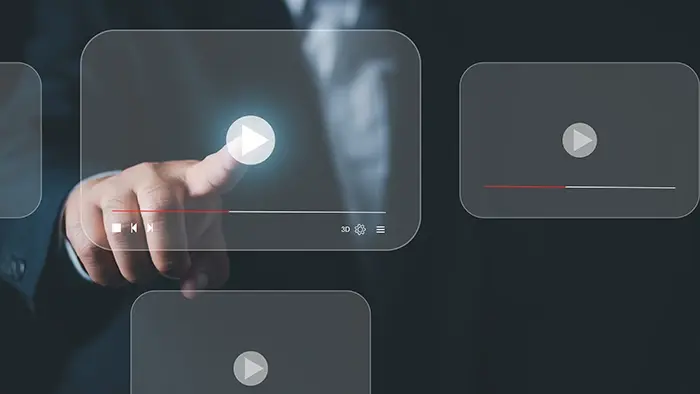Short Video Case Studies: What We've Learned from Haskell's Video Blogs
One of my favorite marketing sayings is, "the best call-to-action on the internet is a video play button." Because it's true. There are plenty of...
6 min read
 Ed Heil
:
May 19, 2022
Ed Heil
:
May 19, 2022
Do you remember what life was like before email, or smartphones, or social networks? It helps to remember all the advances in those areas to understand how much online video has changed over the years. In other words, we've come a long way from the herky-jerky, low-rez videos that barely buffered and frustrated viewers.
Now, video streams are reliable, video production is affordable, and some kinds of video are probably part of your marketing plans. But with the platforms and technology changing so quickly, it's important to understand the types of video content available, but what's right for you this year is probably very different than it would have been just a couple years ago.
Nothing has changed more over the last few years than social videos. Remember when posting an iPhone video on Facebook counted as a smart, spur-of-the-moment social post? There's still a place for those posts — just like there's a place for Snapchat — but most social posts are much more strategic. Ever since Facebook started auto-playing native videos in the newsfeed, marketers have been much more intentional with their social videos.
Facebook: The movement may catch your viewer's eye right away, but the video starts in silence, so you need a good strategy. Start strong and tell your story with and without sound — meaning captions and graphics are a key part of the equation. Facebook users will watch longer videos, but you still need to win over the viewer in the first 10-15 seconds. Consider vertical video since so many Facebook users are on their phones.
Twitter: Although Twitter lagged behind Facebook in the development of native video, you can make the case that videos are now even more effective on the scroll-happy platform. In fact, Twitter says tweets are six times more likely to be retweeted if they include video. Remember to include captions to catch the viewer's attention and that your video will be cropped to fit into a vertical box, which makes sense because 93% of Twitter's video views are on mobile devices. Twitter has increased its maximum video length from 30 seconds to 140, but the shorter videos still seem to perform best on the platform.
Instagram: Although you can have success on Facebook and even Twitter with longer videos, Instagram requires shorter videos. 60 seconds is the maximum (at least for now), and that makes sense. People go to Facebook and Twitter for full updates, Instagram users are looking for pictures. Focus on highly-visual videos, and consider posting short teaser videos to promote videos on other platforms. Remember, all native videos that are captured in the app, as well as your preview thumbnails, will be cropped to fit its square format.
Facebook Live: Live video is the newest kid on the block of social video. Whether it's Facebook Live, Periscope (Twitter), Instagram or any other platform, live video requires plenty of planning. Since it's live — and usually much longer than a pre-produced video — it's important for the host to be comfortable in front of the camera and have a solid plan of what to show or tell.
Remember, you don't get any do-overs on live videos, but you will continue to gain an audience because the recorded version of your video will continue to be seen and shared like any other social post. In fact, Facebook tends to elevate FB Live posts in the newsfeed, so you could get more of a boost than standard posts. Like other social videos, you can use a smartphone or video camera for your live videos. There are a number of apps that add graphics and other features.
PRO TIP: Remember to include links and calls-to-action on your social videos. After all, no matter how many views you get with native videos, you'll still need some extra effort to move those viewers to your own website.
Over the years, a number of tried-and-true types of video have flourished online. You'll be familiar with most of these as they have become the staples of online video, and realistically, they aren't going anywhere. Consider them the building blocks of a video strategy and keep updating them
Culture/About Us Videos: Whether you call it a company video, a culture video, or just the video that appears on the “about us” page of your website, you're probably familiar with this kind of video. Key players in the company explain who you are and what you do. These videos have evolved from stiff interviews with the owner or CEO to more inclusive videos that actively introduce key stories and people, and show off what really makes the company tick. Done right, your video will show off your culture and even serve as a virtual tour for out-of-town HR prospects.

Interviews/Stories: Video is a wonderful way to tell a story. We've been watching interviews on TV for decades and continue to watch them online. You can convey thought leadership with simple sound bites or tell a complex story by mixing words, pictures, music, and graphics. Either way, make sure your story is interesting and your spokespeople credible, because a video is the ultimate truth detector. Since we've been watching it for years, the audience can easily tell the difference between a real story and a commercial. Don't try to fool them.

Tutorials/How-To Videos: When people want to know more about you or your product, there’s nothing better than tutorial or demonstration. Whether it’s a casual “show-and-tell” video, a complicated “how it works” explanation, or a highly produced “demo reel,” depends on the product and the persona. Remember, there's a reason "how to" is one of the most searched terms on YouTube.

Product Videos: In essence, these are short commercials (or show-and-tell videos) that highlight your product’s best features. When should you use them? Any time a prospect might look at a product catalog or truly want to learn more about your product. In fact, "learn more" links are a great way to introduce product videos. Be sure the lighting and production value are high quality — these videos are for viewers who are likely interested in buying the product.

Explainer Videos: When you have a complex topic, like a software startup, using animating graphics is an easy way explain your value proposition. The key is to explain the need, who it helps, and how it works all in the first minute. The weakness of explainers is that they only showcase your abstract idea, not its real-world impact, so it's ideal to follow-up an explainer video with a testimonial video (see next) to prove your product really works.

Testimonial (Video Case Studies): Few things are more credible than real people giving real feedback about a product or service. That’s why customer reviews are so useful online. Better yet, video reviews or testimonials give the viewer an opportunity to see and hear that endorsement, to vet whether their story sounds sincere.

Vlogs or Video Blogs: Video blogs (vlogs) are short, simple videos that should focus on one person making one main point for about one minute. It's hard to keep them that simple, but remember that everything else can be shown or said with a follow-up video on your website. Video blogs can be used for testimonials and thought leadership, but the best ones use the video to show something useful or unique. No matter what, be sure to optimize the blog for search engines by transcribing the video.

PRO TIP: Remember that you can make shorter versions of most of these videos to use as "teasers" on your social channels. Cut a 20-second sound bite or a montage with graphics to tell the story and finish it with a "watch the whole story" link leading to your own website.
With technology changing so quickly, it's always important to have your eyes on the next frontier, but that doesn't mean you have to put every new technology in this year's marketing plans. The technology is available to produce the next two types of video, but the audience may not be quite ready yet. Feel free to experiment, because first movers put themselves in a great position whenever a new technology moves from the frontier to the mainstream (and tipping points in technology come really quickly), but be aware that at this point you're efforts are really an investment in the future.
4K Video: I know, I know...your smartphone shoots 4k video and your TV can show it, but how about the infrastructure in between? That's the issue. When you shoot professional quality video in 4K, it uses 4-times as much data — everywhere. That means 4-times the processing time when you're editing, 4-times the storage space (be ready to buy more hard drives), 4-times the data to upload/download when distributing it, and 4-times the data for your viewer to process. In other words, each step is a lot slower and clunkier including viewing. Don't believe me? Find a 4K video on YouTube and try to watch it in all its 4K glory. We're getting close, but in most cases, it's not quite ready for prime time.
360º Videos: This is another great idea that still takes too much time to execute. Although 360º video is a great way to take a viewer somewhere (a house tour, a new building or venue), it's not quite ready for most applications. For starters, it's time-consuming to make. Although the cameras are affordable, and you can even make a simple 360º images with an iPhone, it takes a lot of editing and a lot of skill to "stitch the video together" and create a truly immersive 360º experience. Right now, the rule of thumb is that unless you have interesting action in both directions (like a concert in front of you and the crowd behind you), it's probably not worth the time and effort.
Right now, social videos are exploding and the old-standbys are gaining even more traction. But tune in next year — or even next month — because this list is guaranteed to change. That's the nature of video.
Editor's Note: This blog was written in 2020 and updated in 2021.

One of my favorite marketing sayings is, "the best call-to-action on the internet is a video play button." Because it's true. There are plenty of...

You’ve wrapped a video project, the final file’s in your inbox, and it looks fantastic. But now what?

Editor's note: This post originally published in 2020 and was updated in September 2023. Did you know that consumers are watching over 5 billion...